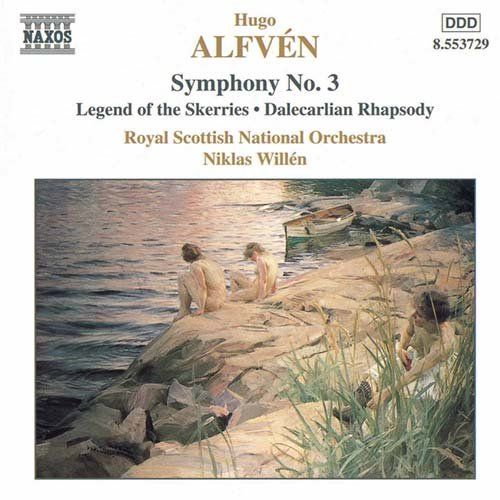Hugo Alfvén's Symphony No. 3; and more ...
Explore the music of Hugo Alfvén ...

Hugo Emil Alfvén (1872-1960) was a Swedish composer - alongside the shorter-lived Wilhelm Stenhammar (1871-1927), he was one of the best-known composers of his time in that country. His family generally seems to have achieved some fame: his daughter, Margita Alfvén, was a star of the silent era of films, while his nephew Hannes Alfvén received a Nobel prize in physics in 1970.
Inspired by a trip to Italy, Alfvén’s Third Symphony was completed in 1905. The actual location in Italy was the Ligurian town of Sori (just outside Genoa), and this piece is an expression of the joy of living itself - small wonder , if you've ever been to Liguria!. There is no programme; but Alfvén did say that it “is an expression of the sunlit happiness that filled my whole being” while in Italy and with the woman he loved. The symphony's premiere took place in Gothenberg in 1906, followed by its Stockholm premiere a few months later.
Indeed, the first movement positively bursts with radiance - any dissonances firmly lead to explosions of light. This seems to be a repeated trope in this movement, with those arrival points inevitably comprising passages of infectious, dance-like rhythms:
The melodious Andante is the longest of the four movements, deftly written and beautifully performed here (particularly by the RSNO's woodwinds and their delightful contributions). The piece enjoys an expansive climax, given all the space in the world here by Willén:
The Scherzo flickers nicely. It is marked “Presto” and is indeed fast and light - a sort of Scandic Mendelssohn perhaps, although (and this might be fanciful) certain passages reminded me of the scherzos of Louise Farrenc, whose symphonies provided yesterday’s post, but with a bit of a Swedish accent:
The finale is fascinating, switching mood suddenly, quickfire and skittish in demeanour (the Scottish National's violins are partiularly impressive here) with nice little lyrical moments for contrast:
The disc provides a later work, the Dala-rhapsodien (Dalecarlian Rhapsody) of 1931. It is shot through with nostalgia (as were many of Alfvén's late works): the setting is the woods and mountains north of Lake Siljan, and many of the themes are taken from that region. There is a sepcific programme by the composer which, while not mandatory, is rather nice to imagine alongside the music, full of beautiful (and well-orchestrated) tunes:
I imagine a shepherd girl sitting on the grass at her mountain farm in the quiet and deserted woodlands, blowing her horn. I wish to depict her dreams, her longing. In the distance he hears a bridal procession pass by and in her dreams she is once more among her friends down in the village. She remembers many dances in the evenings and church on Sundays and the exalted, solemn hymns. She shivers as she remembers the night when a strange man appeared among them, seized a fiddle and pplayed wild and strange tunes that made the people go mad. It was the Devil himself. The shepherd girl starts up with a cry fo fear, then she wakes from her horrible dream and looks around in confusion. Quietly she takes to her horn again. I hear the same melody as in the beginning. And the woods answer her, sighing deeply.
This is the last of Alfvén's three Rhapsodies and was premiered under the baton of the composer in Stockholm in 1932. The performance here is nicely done by the Royal Scottish National Orchestra, particularly in the cumulative wildness of the dances:
The Legend of the Skerries, Op. 20 (En skärgårdssägen, which can also be translated as ”A Tale from the Archipelago”) was written in 1904 and premiered, conducted by the composer, in Stockholm the next year, “My innermost self belongs to the skerries,” said Alfvén; ‘I have had my best ideas when sailing on dark and stormy nights. The wild autumn has been my greatest inspiration”; Alfvén links the glowering orchestral sonorities to human passions, via the inspiration of Nature. “Against the background of the dark and threatening sea a fateful drama of the vanity of human love is enacted,” he said, and we shall return to that idea when we consider his Fourth Symphony in a later post. Here, revel in the expert orchestration, nicely brought to life by Willén, who also finds a rather nice sense of flow in his performance:
This lovely disc is available at Amazon for around £9, with second-hand copies going at the time of writing for a mere £1.38. The box of the complete symphonies with orchestral works goes for £33.67.
